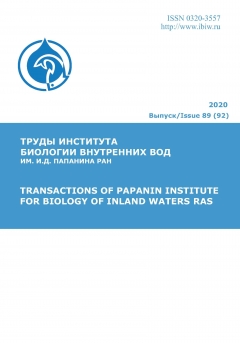employee from 01.01.2021 to 01.01.2024
UDC 547.379.3
UDC 591.3
UDC 57.081
The cell parameters of peripheral blood of Danio rerio exposed for 30 days to aqueous solutions of dimethyl disulfide (DMDS) different concentrations were studied using light microscopy. It was shown that significant changes in the studied parameters were observed only at a DMDS concentration of 5 mg/L. A shift in the leukocyte formula was noted towards a decrease in lymphocytes and an increase in the proportion of granulocytes (mainly metamyelocytes and band granulocytes). The proportions of other cell types did not exceed 2–6%. A statistically significant shift in the composition of red blood cells towards a decrease in the proportion of mature and an increase in the proportion of immature erythrocytes, erythrocyte size variations, and amitosis were also observed. No differences in the level of micronuclei were noted between the control and experimental groups of fish.
Danio rerio, erythrocytes, leukocytes, peripheral blood, dimethyl disulfide
1. Belova N.V., Psurceva N.V. Serosoderzhaschie aromaticheskie soedineniya, toksiny i farmakologicheski aktivnye metabolity makromicetov // Mikologiya i fitopatologiya. 2021. T. 55, № 1. S. 3–10. DOI:https://doi.org/10.31857/S0026364821010049.
2. Golovina N.A., Strelkov Yu.A., Voronin V.N., Golovin P.P., Evdokimova V.B., Yuhimenko L.N. Ihtiopatologiya. M.: Mir, 2007. 448 s.
3. Zabotkina E.A., Lapirova T.B. Vliyanie pesticidov na immunofiziologicheskoe sostoyanie ryb // Uspehi sovremennoy biologii. 2004. T. 124, № 4. S. 354–361.
4. Zabotkina E.A., Lapirova T.B., Serednyakov V.E., Nesterova T.A. Ekologicheskaya plastichnost' gematologicheskih pokazateley presnovodnyh kostistyh ryb // Trudy Instituta biologii vnutrennih vod im. I.D. Papanina RAN. 2015. № 72(75). S. 16–29.
5. Ivanova N.T. Atlas kletok krovi ryb. M.: Leg. i pisch. prom-st', 1983. 80 c.
6. Karpov A.B., Zhagfarov F.G., Kozlov A.M. Snizhenie koksootlozheniya v pechah piroliza s pomosch'yu ingibitora koksoobrazovaniya // Neftepererabotka i neftehimiya. 2015. № 11. S. 21–25.
7. Meschakova N.M., Benemanskiy V.V. Ocenka biologicheskogo deystviya dimetildisul'fida s uchetom specificheskih otdalennyh effektov // Byulleten' VSNC SO RAMN. 2005. № 2(40). S. 209–212.
8. Pavlushkina D.A. Vliyanie dimetildisul'fida na pokazateli perifericheskeoy krovi i kletki zhabernogo epiteliya Danio rerio v eksperimente // Aktual'nye problemy biomediciny. Materialy XXVII Vseross. Konf. molodyh uchenyh s mezhdunarodnym uchastiem. Sankt-Peterburg, 2021. S. 247–248.
9. Soboleva N.A., Kalaev V.N., Nechaeva M.S., Kalaeva E.A. Opredelenie minimal'nogo kolichestva analiziruemyh bukkal'nyh epiteliocitov na preparate pri provedenii mikroyadernogo testa // Vestnik VGU, Seriya: Himiya. Biologiya. Farmaciya. 2016. № 3. S. 80–84.
10. Anastassiadou M., Arena M., Auteri D., Barmaz S., Brancato A. et al. Conclusion on the peer review of the pesticide risk assessment of the active substance dimethyl disulfide // EFSA Journal. 2019. Vol. 17. № 11. 28 p. DOI:https://doi.org/10.2903/j.efsa.2019.5905.
11. Barnes I., Becker K.H. An FTIR Product Study of the Photooxidation of Dimethyl Disulfide // J. Atm. Chem. 1994. Vol. 18. P. 267–289. DOI:https://doi.org/10.1007/BF00696783.
12. Kucherskoy S.A., Alikbaeva L.A. In vivo toxicity study of dialkyl disulphides // Extrem. Med. Sci. Practic. Rev. J. FMBA Rus. 2021. № 2. DOI:https://doi.org/10.47183/mes.2021.015.
13. Livanova A.A., Zavirsky A.V., Kravtsov V.Yu. Danio rerio as an Experimental Model in Radiobiology // Rad. Boil. Radioecol. 2020. Vol. 60. № 2. P. 163–174. DOI:https://doi.org/10.31857/S0869803120020095.
14. Mahmoud M.A. A., Tybussek T., Loos H.M., Wagenstaller M., Buettner A. Odorants in Fish Feeds: A Potential Source of Malodors in Aquaculture // Front. Chem. 2018. Vol. 6. Art. 241. DOI:https://doi.org/10.3389/fchem.2018.00241.
15. Mashkina A.V., Khairulina L.N. Reaction of dimethyl disulfide with thiophene catalyzed by zeolite // Rus. J. Org. Chem. 2015. Vol. 51. № 2. P. 217–220. DOI:https://doi.org/10.1134/S1070428015020141.
16. Morgott D., Lewis C., Bootman J., Banton M. Disulfide oil hazard assessment using categorical analysis and a mode of action determination // Inter. J. Tox. 2014. Vol. 33. Suppl. 1. P. 181S–198S. DOI:https://doi.org/10.1177/1091581813504227.
17. Mulay P.R., Cavicchia P., Watkins S.M., Tovar-Aguilar A., Wiese M., Calvert G.M. Acute illness associated with exposure to a new soil fumigant containing dimethyl disulfide — Hillsborough County, Florida, 2014 // J. Agromedicine. 2016. Vol. 21. № 4. P. 373–379. DOI:https://doi.org/10.1080/1059924X.2016.1211574.
18. Schoelitsz B., Mwingira V., Mboera L.E.G., Beijleveld H., Koenraadt C.J.M. et al. Chemical Mediation of Oviposition by Anopheles Mosquitoes: a Push-Pull System Driven by Volatiles Associated with Larval Stageshttps // Journal of Chemical Ecology. 2020. Vol. 46. P. 397–409. DOI:https://doi.org/10.1007/s10886-020-01175-5.
19. Vandeputte A.G., Reyniers M.-F., Marin G.B. Theoretical Study of the Thermal Decomposition of Dimethyl Disulfide // J. Phys. Chem. A. 2010. Vol. 114. P. 10531–10549. DOI:https://doi.org/10.1021/jp103357z.
20. Why A.M., Choe D.-H., Walton W.E. Identification of Chemicals Associated Gambusia affinis (Cyprinodontiformes: Poeciliidae), and Their Effect on Oviposition Behavior of Culex tarsalis (Diptera: Culicidae) in the Laboratory // J. Med. Entomol. 2021. Vol. 58. № 6. P. 2075–2090. DOI:https://doi.org/10.1093/jme/tjab078.
21. Wu T., Wang M., Wang P., Tian H., Zhan P. Advances in the formation and control methods of undesirable flavors in fish // Foods. 2022. Vol. 11. P. 2504. DOI:https://doi.org/10.3390/foods11162504.
22. Yin F., Grosjean D., Seinfeld J.H. Photooxidation of Dimethyl Sulfide and Dimethyl Disulfide. I: Mechanism Development // J. Atm. Chem. 1990. Vol. 11. P. 309–364. DOI:https://doi.org/10.1007/BF00053780.








